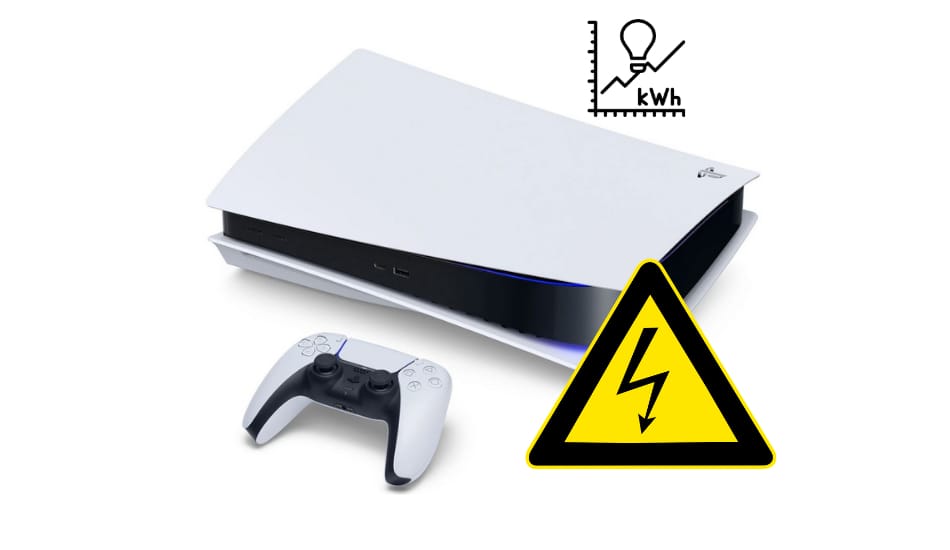PS5 Electricity Cost (5 Tips To Save Money)

The PlayStation 5 (PS5), Sony’s latest gaming console, has brought impressive advancements in gaming technology, but it also raises concerns about electricity consumption. Understanding the PS5’s power usage is very important for gamers who are worried about their energy bills and environmental impact. In this article, we’ll talk about PS5 power consumption and much more. So, let’s start!
So How Much Power Does PS5 Use? The PlayStation 5 consumes approximately 200 to 220 watts of power when running games, making it one of the most power-intensive gaming consoles on the market. Therefore, running a PS5 for 1 hour will cost you $0.046, while the yearly electricity cost will be around $15.54.
On average, operating a PS5 in the United States costs around $0.046 per hour, which is slightly over 4 cents. The PS5 Digital Edition sees a minor reduction in cost, at approximately $0.044 per hour.
For an average gamer in the U.S., the weekly cost is around $0.31, while the monthly and annual expenses go up to $1.33 and $15.99. The PS5 Digital Edition has slightly lower costs, with weekly, monthly, and yearly expenses expected to be $0.30, $1.29, and $15.54, respectively.
In the following sections, learn more about the electricity calculations, compare the PS5’s power usage with other household devices, and learn five energy-saving tips for the PS5 that could help you save money and lessen your environmental impact.
Related Article: How Much Power (Watts) Does USB Webcam Use?
Table of Contents
How Much Electricity Does a PS5 Use?

According to Sony’s specifications, the PS5 has a power rating of 350W, whereas the PS5 Digital Edition has a slightly lower rating of 340W. Keep in mind this is the maximum. To give a comparison, the original PS4 had a power rating of 250W, and the PS4 Pro comes in at 310W.
However, it’s important to note that these figures represent the maximum power ratings. In practice, the PS5’s actual power usage typically falls below this threshold since the consoles do not operate at full capacity continuously. The power usage may approach the 350W or 340W mark, primarily during intense gaming sessions with demanding titles.
Energy consumption is significantly less for activities like streaming content from Netflix or YouTube. Although it was estimated that standby mode would only use about 0.5W, recent tests have indicated that it actually consumes approximately three (3x) times that amount.
With this in mind, let’s examine the PS5’s various power consumption levels across different operating modes.
PS5 Power Consumption Breakdown
The following table shows the peak electricity consumption rates for the PS5 across various modes based on the highest values recorded.
| Mode | Electricity Consumption |
|---|---|
| Power Off | 1.3W |
| Standby (Network Disabled) | 1.5W |
| Dashboard | 47W |
| Gaming (Max Found To Date) | 203W |
| Max Capacity | 350W |
The PS5’s different operating modes result in different levels of electricity consumption. In standby mode without a network connection, the PS5 uses 1.5W. Even when turned off yet plugged into the outlet, the PS5 draws around 1.3W. With a maximum power rating of 350W for the console, the highest recorded consumption during gaming sessions is 203W.
PS5 Power Consumption Calculator
In this section, you will learn how much electricity your PS5 utilizes hourly, daily, weekly, monthly, and annually. To calculate your PS5’s electricity usage, just input your daily operation time for each mode.
The calculator comes pre-set with data for the standard edition of the PS5, including its power consumption when turned off but connected to a power source.
Adjust the wattage values as necessary to match your actual usage. Refer to the PS5 Power Consumption Breakdown table provided above to view the power usage for different modes such as Gaming, Dashboard display, and Standby with the network turned off.
PS5 Power Consumption Calculator
Does PS5 Consume a Lot of Electricity?
The PS5 is one of the most power-intensive gaming consoles on the market, with a power rating that surpasses most other mainstream gaming devices. This makes the PS5 comparatively more energy-demanding.
To put it in perspective, other household items with a 350W rating include certain blenders, cordless vacuum cleaners, and stand mixers. Unlike electric heaters, air conditioners, and electric showers, these appliances typically aren’t labeled as high-energy consumers.
However, if a 350W blender were used as frequently as gamers use their consoles, its energy consumption would be seen differently.
In their study “Toward Greener Gaming: Estimating National Energy Use and Energy Efficiency Potential,” Mills and colleagues (2019) assess the energy usage of computer gaming (beyond just consoles) and compare it to that of common household appliances.

Computer gaming as a whole uses more electricity than appliances like freezers and ovens, though it consumes significantly less than systems used for space heating and cooling.
The PS5, as part of the broader category of “Computer gaming,” is likely to be a significant contributor to this consumption, especially considering the strong market presence of its predecessors in the PlayStation series.
To understand the specific energy usage of the PS5, we should examine the electricity costs associated with its operation. This analysis will help quantify its impact compared to other devices and activities within the home.
Related Article: How Much Power (Watts) Does Laptop Use In Sleep Mode?
How Much Does it Cost to Run a PS5 per Hour in the US?
Considering the current average electricity cost of 15 cents per kWh in the U.S. and the PS5’s power rating, we can calculate the cost of operating a PS5 for 1 hour at its maximum power output.
On average, it costs approximately $0.0525 (just over 5 cents) to run a PS5 for 1 hour. This slightly reduces to $0.051 (again, just over 5 cents) per hour for the PS5 Digital Edition.
Cost to run a PS5 per week, month, and year in the US
In the U.S., gamers typically play for about 6.8 hours per week. Using this average, along with the maximum power ratings for both the PS5 and the PS5 Digital Edition and an updated average electricity cost of 15 cents per kWh, we can calculate the annual cost of running a PS5.
| Console | Power Rating (W) | Cost per Week ($) | Cost per Month ($) | Cost per Year ($) |
|---|---|---|---|---|
| PS5 | 350 | $0.31 | $1.33 | $15.99 |
| PS5 Digital Edition | 340 | $0.30 | $1.29 | $15.54 |
These costs will naturally differ based on usage, including gaming, downloading, and streaming activities. However, these figures provide a realistic estimate of what gamers might expect to pay in terms of electricity charges over the course of a year.
Now, let’s briefly examine the electricity costs for running a PS5 in the UK.
Calculating the Hourly Cost to Run a PS5 in the UK
With the UK’s average electricity rate of around 17p per kWh, it’s straightforward to estimate the cost of running a PS5 based on its power rating and assuming it operates at maximum capacity. On average, it costs £0.06 to operate a PS5 for 1 hour. For the PS5 Digital Edition, the cost is slightly lower at approximately £0.058 per hour.
Cost to run a PS5 per week, month, and year in the UK
In the UK, the average gamer spends about 6.89 hours per week engaged in video games. By applying this average gaming duration, the typical electricity price, and the power specifications of the PS5, we can calculate the weekly, monthly, and annual costs to operate a PS5 (at maximum power) in the UK as follows:
| Console | Power Rating (W) | Cost per Week (£) | Cost per Month (£) |
|---|---|---|---|
| PS5 | 350 | £0.41 | £1.78 |
| PS5 Digital Edition | 340 | £0.40 | £1.73 |
Several factors can affect your overall electricity usage. For instance, if you use your PS5 less frequently than the typical gamer or if you prefer streaming over playing demanding games, your electricity consumption – and consequently your costs – will be lower.
To get a more precise estimate:
Use our PS5 calculator above to get better understanding on how much power it will cost you to run it over time.
5 Tips to Reduce PS5 Electricity Consumption

Frame rate, GPU, and cloud gaming significantly impact electricity consumption during gaming. However, small behavioral changes can save money and reduce your carbon footprint without affecting your gaming experience.
Here are five simple ways to cut down on your PS5’s electricity usage:
- Enable Power Saving Mode: Manually activate this feature to join PS5 owners saving energy equivalent to 1,000 US homes.
- Avoid Streaming on Your PS5: Streaming consumes a lot of power. Opt for devices like Chromecast, Apple TV, or Amazon Fire TV, which use less energy. If you have a smart TV, stream directly from it for minimal electricity usage.
- Auto-Off for Controllers: Set your controllers to turn off automatically when not in use. This minor adjustment can save energy and make your gaming setup more convenient.
- Direct HDMI Connection: Avoid using set-top boxes with your console. Utilize the multiple HDMI ports on modern TVs for direct connections, which are more energy-efficient.
- Unplug When Not in Use: Standby mode still consumes electricity. Unplug your PS5 during long periods of inactivity, like overnight, to save energy.
For more information on greener gaming practices, check out Green Gaming. You can also explore the average TV wattage and calculate the combined cost of running your TV and PS5. By implementing these tips, you can enjoy your PS5 while being mindful of your energy consumption and environmental impact.
Final Thoughts
Understanding the PlayStation 5’s electricity consumption is very important for gamers who are conscious of their environmental impact and household energy costs. While the PS5 offers cutting-edge technology and unparalleled gaming experiences, it also demands significantly more power than previous models.
By using tools like online calculators, gamers can get a clearer picture of their consumption and find ways to optimize their usage. Ultimately, being aware of the energy implications helps ensure that gaming remains both an enjoyable and sustainable hobby.








